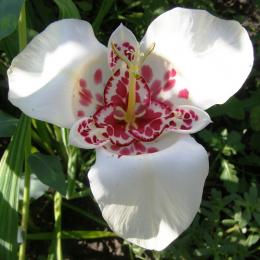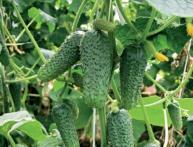Growing tigridia: planting, propagation, watering

Tigridia got its name due to the variegated pattern of the flower throat, which resembles the color of a tiger. This is a bulbous plant, there are about 20 species in nature.
Growing Tigridia lies in the correct choice of location, watering and care. Give it a sunny place on the site. It must be protected from winds. Preferably neutral or alkaline soils. Grows well in light, fertile and well-drained soil. Growing tigridia is similar to growing gladioli. In hot weather, watering is required.
In autumn before frost sets in Corms should be dug up and transfer to a cool room where the temperature will be 4 - 7 degrees Celsius. It is good to sprinkle the bulbs with dry sand, as they tend to dry out. They need to be handled with care and do not take impacts.
After the frost has receded in May, tigridia are planted in the area at a depth of 8 - 10 cm in small groups of up to 15 pieces with a distance of 20 - 30 cm.
Unfortunately, Each flower delights with its wonderful blooming only for one day. Therefore, they are planted in groups, giving the impression that the flowering period is long.
After planting, tigridia needs feeding nitrogen fertilizers. 30 - 40 grams of nitrogen fertilizers are used per square meter. When the first buds appear, nitrophoska is added. During the flowering period, tigridia is watered abundantly.
Propagate tIgridia can be grown by seeds and babies. The seeds ripen in October and are sown at the end of February.When 2 leaves appear, the plant is planted in a separate pot, and in the spring from the pot into the ground. It is necessary to plant without touching the root system; it is better to do this together with a lump of earth.








